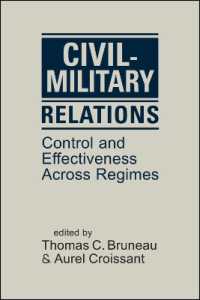Full Description
When communities face complex public health emergencies, state local, tribal, and territorial public health agencies must make difficult decisions regarding how to effectively respond. The public health emergency preparedness and response (PHEPR) system, with its multifaceted mission to prevent, protect against, quickly respond to, and recover from public health emergencies, is inherently complex and encompasses policies, organizations, and programs. Since the events of September 11, 2001, the United States has invested billions of dollars and immeasurable amounts of human capital to develop and enhance public health emergency preparedness and infrastructure to respond to a wide range of public health threats, including infectious diseases, natural disasters, and chemical, biological, radiological, and nuclear events. Despite the investments in research and the growing body of empirical literature on a range of preparedness and response capabilities and functions, there has been no national-level, comprehensive review and grading of evidence for public health emergency preparedness and response practices comparable to those utilized in medicine and other public health fields.
Evidence-Based Practice for Public Health Emergency Preparedness and Response reviews the state of the evidence on PHEPR practices and the improvements necessary to move the field forward and to strengthen the PHEPR system. This publication evaluates PHEPR evidence to understand the balance of benefits and harms of PHEPR practices, with a focus on four main areas of PHEPR: engagement with and training of community-based partners to improve the outcomes of at-risk populations after public health emergencies; activation of a public health emergency operations center; communication of public health alerts and guidance to technical audiences during a public health emergency; and implementation of quarantine to reduce the spread of contagious illness.
Table of Contents
Front Matter
Abstract
Summary
1 Advancing Public Health Emergency Preparedness and Response System Capabilities to Respond to Increasing Threats
2 The Landscape and Evolution of Public Health Emergency Preparedness and Response Research in the United States
3 An Evidence Review and Evaluation Process to Inform Public Health Emergency Preparedness and Response Decision Making
4 Engaging with and Training Community-Based Partners to Improve the Outcomes of At-Risk Populations
5 Activating a Public Health Emergency Operations Center
6 Communicating Public Health Alerts and Guidance with Technical Audiences During a Public Health Emergency
7 Implementing Quarantine to Reduce or Stop the Spread of a Contagious Disease
8 Improving and Expanding the Evidence Base for Public Health Emergency Preparedness and Response
Appendix A: Detailed Description of the Committee's Methods for Formulating the Scope of the Reviews and Capturing the Evidence
Appendix B: Mixed-Method Reviews of Selected Topics
Appendix B1: Mixed-Method Review of Strategies for Engaging with and Training Community-Based Partners to Improve the Outcomes of At-Risk Populations
Appendix B2: Mixed-Method Review of Activating a Public Health Emergency Operations Center
Appendix B3: Mixed-Method Review of Channels for Communicating Public Health Alerts and Guidance with Technical Audiences During a Public Health Emergency
Appendix B4: Mixed-Method Review of Implementing Quarantine to Reduce or Stop the Spread of a Contagious Disease
Appendix C: Commissioned Reports That Informed the Four Mixed-Method Reviews
Appendix D: Commissioned Scoping Review and Series of Evidence Maps
Appendix E: Public Committee Meeting Agendas and Proceedings of a Workshop—in Brief
Appendix F: Committee Member Biosketches








